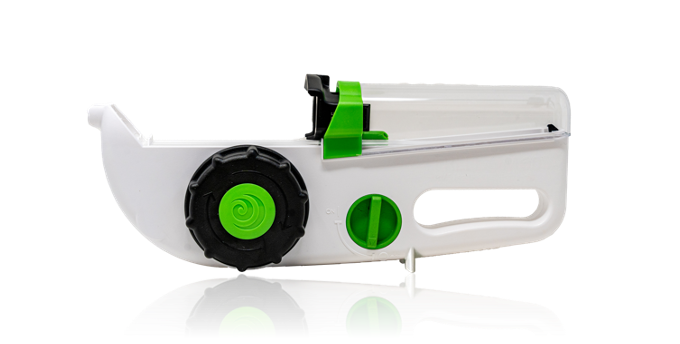Easy to use and completely portable, the Freedom60® infusion pump is ideal for subcutaneous immune globulin infusions at home. Give patients the freedom of convenience without compromise.
More than just a single pump, we offer a complete Freedom™ Infusion System. For small volume infusions (<30 mL), choose FreedomEDGE® Syringe Infusion Pump.


“I absolutely love the Freedom60 pump – it’s super easy to use and it comes with a pouch so you can take it with you and move around! Also, love the HigH-Flo sub-q needle sets – less pain with insertion and they come with brand name Tegaderm! Thank you for the awesome products!”
Christina B.
Immunoglobulins*1
* Please note: The Freedom60® is specifically indicated for the subcutaneous infusion in the home, hospital, or ambulatory settings when administered according to the approved biologic.
Antibiotics†1
† The Freedom™ Infusion System with the Freedom60® Syringe Infusion Driver and Precision™ Flow Rate Tubing, is specifically indicated for the intravenous infusion of these antibiotics when used according to the approved drug product labeling.
Additional indication outside the US: subcutaneous hydration with electrolyte solutions (±15%).
Highest Quality
Made in the USA with high quality materials in ISO 13485 facility.
Designed With Safety in Mind
Designed using state of the art standards for drug delivery medical devices.
Portable
No batteries or electricity needed. Comes with a travel pouch to promote patient independence.
DynEQ™ (Dynamic Equilibrium)
Dynamic response – if the pressure increases at the infusion site, the system immediately slows down.
Rugged
Robust design with a molded ABS plastic housing. No sensitive electric parts.
Easy to Handle
Fits syringes smoothly.
Simple Controls
Easy to use recessed ON/OFF switch.
Large Knob, Cannot be Overwound
Dexterity friendly.
Syringe Held Securely during Infusion
Spring-loaded holder locks syringe into the pump and maintains proper syringe orientation.
Syringe Protection
Syringe is secure during infusions.



First, verify that your tubing is the right flow rate. Then, check that the pump winds properly and makes a noise when turned on – this means the pump is working properly. Finally, note the time the infusion starts and watch that the syringe plunger moves in accordance with your estimated infusion time. If there is any doubt, please talk to your healthcare provider.
Always refer to the medicine’s prescribing information and recommendations from your healthcare provider for infusion site locations. If you are experiencing site reactions or discomfort talk to your healthcare provider. If you are experiencing slow infusions, you can time your infusion to see how well your body accepts the drug. Talk to your healthcare provider about switching infusion sites or adjusting your needles or tubing to better suit your needs. For more details, please refer to the Instructions for Use.
Refer to the Instructions for Use for detailed instructions.
If a dose is larger than the syringe size that you have, you can divide the dose into additional syringes using the same tubing and needle set. Follow the instructions in the Freedom60® IFU (and your healthcare provider’s protocol) for using multiple syringes. For smaller volumes, simply fill the syringe to the desired amount. You can also try the FreedomEDGE®, which accommodates 20 or 30 mL syringes.
The Freedom60® Syringe Infusion System is indicated for the subcutaneous infusion of the following human plasma-derived immunoglobulins when used according to the FDA approved biologic labeling: Cutaquig®, Immune Globulin Subcutaneous (Human) 16.5% Solution (manufactured by Octapharma®); Cuvitru®, Immune Globulin Infusion (Human) 20% (manufactured by Takeda®); Gammagard Liquid®, Immune Globulin Infusion (Human) 10% (manufactured by Takeda®); Hizentra®, Immune Globulin Subcutaneous (Human) 20% Liquid (manufactured by CSL Behring®); and Xembify®, Immune Globulin Subcutaneous (Human) 20% Liquid (manufactured by Grifols®) in the home, hospital, or ambulatory settings when administered according to the approved biologic or drug product labeling.
The Freedom60® Syringe Driver and Precision™ Flow Rate Tubing is also indicated for the intravenous infusion of the following antibiotics when used according to the FDA approved drug product labeling: ertapenem, meropenem, oxacillin, and tobramycin.
Speak with your healthcare provider to learn more about all the Precision Flow Rate Tubing™ choices available, and to see if a change is appropriate.
The Freedom60® is designed to operate without scheduled maintenance. If you ever experience a pump problem, immediately advise your healthcare provider who can arrange for a replacement if necessary.
Please contact the provider who sent you your pump.